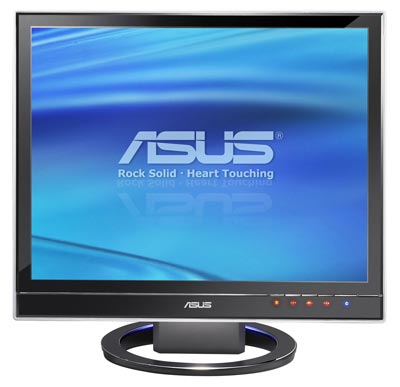ASUS LS201 20" LCD Monitor
Videos of violence committed against electronics are nothing new. There are hundreds of videos on You Tube depicting the untimely demise of all manor of electronics from mp3 players to whole computer sets, printer and all. The abuse of a perfectly good LCD monitor isn't what struck us about this particular video. The unique element in this video that caught our eye and set it apart from the others is that the LCD monitor survived the episode completely unscathed. In fact, the screen was powered on through the entire ordeal and was happily displaying what appears to be an animated sales presentation.
The pen knife didn't leave a mark and the barrage of hammer blows failed to make any progress. The little girl and her deadly permanent marker? Wiped right off. Perhaps it was actually a dry-erase marker. Surely the crossbow was able to make some progress? Both of the deadly metal bolts, fired from within ten feet, bounced off harmlessly leaving the tip of each bolt bent into a hook but the monitor remained unscathed. Color us impressed.
As technology pundits, we couldn't simply sit back and enjoy this peculiar Russian-language video set to a catchy neo-classical tune. Not when there were burning questions to be answered. Questions like who makes it? What are the specs? How much does it cost? Where is it sold? Is crossbow proofing a legitimate feature? Does it have A/V inputs for hooking up a Wii?
The answer to the first question was obvious from the video. The monitor is an ASUS product. With this first clue in hand, we set off to find the answer to the rest of these questions and what better way to do that than through a full review? Let's meet the ASUS LS201.
|
| Display Size | 20" diagonal and viewable image |
| Display Type | Thin-Film Transistor LCD Active Matrix, TN panel |
| Display Viewing Angle | 170 degrees horizontal, 160 degrees vertical |
| Input Terminal | Analog (15-pin D-sub VGA) and Digital (DVI-D) |
| Display Brightness | 300 cd/m2 (typical) |
| Native Resolution |
SXGA+ 1400x1050 @ 60 Hz |
| Contrast Ratio | 2000:1 (Dynamic Contrast Ratio) |
| Display Color | 16.7 Million |
| Response Time | 5 ms (GTG) |
| Pixel Pitch | 0.291 mm |
| Power Source | Input Rating: 100 to 240V~ |
| Power Consumption | 42W in operating mode, <2W in power saving mode |
| Stand | Tilt +20° ~ -5° |
| Mounting | VESA Wall Mounting: 100 x 100mm (equipped with adapter) |
| Dimensions | 18.0 x 17.3 x 10.2 in. (458 x 439 x 260 mm) |
| Weight | 16.53 lbs. (7.5 Kg) |
| Regulation Approval | Energy Star®, CE, CB, FCC, CCC, UL/cUL, BSMI, C-tick, VCCI, MIC, PSB, RoHS, WHQL |
| Included Accessories | DVI cable, VGA cable, power cord, adapter, user manual disc, warranty card, quick start guide, cleaning cloth, wall-mount adapter |
| Special Features |
9H Hardness Protection Glass, Anti-reflection coating (<2%), Light-In-Motion lighting effect, Splendid™ Video Intelligence Technology |
While most people are pretty happy with a widescreen LCD, there are some people who hold the opinion that a standard aspect ratio is more fitting for a computer monitor. One disadvantage of widescreen monitors that the latter camp likes to point out is that widescreen monitors often sport less pixels vertically than a standard aspect ratio monitor of similar size. We'd like to point out that the LS201 has the same number of pixels, vertically, as most widescreen 20" and 22" monitors, which generally have resolutions of 1680x1050. So the LS201 should have the same amount of vertical desktop real estate as a larger 22" screen.
The rest of the LS201's technical specifications appear to be fairly typical for a LCD monitor built on a TN panel. Of course, the truly unique feature of the LS201, which was so graphically demonstrated in the video, has nothing to do with the panel technology it uses.







